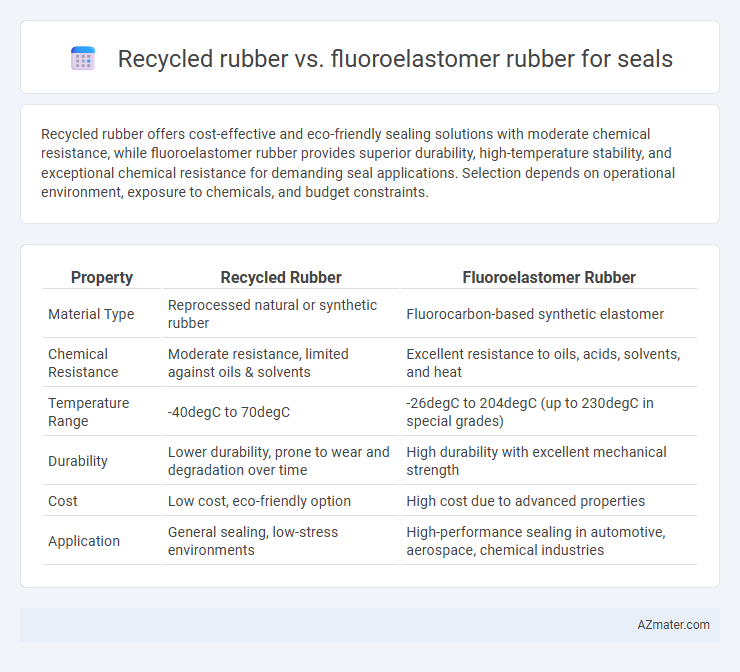Recycled rubber offers cost-effective and eco-friendly sealing solutions with moderate chemical resistance, while fluoroelastomer rubber provides superior durability, high-temperature stability, and exceptional chemical resistance for demanding seal applications. Selection depends on operational environment, exposure to chemicals, and budget constraints.
Table of Comparison
| Property | Recycled Rubber | Fluoroelastomer Rubber |
|---|---|---|
| Material Type | Reprocessed natural or synthetic rubber | Fluorocarbon-based synthetic elastomer |
| Chemical Resistance | Moderate resistance, limited against oils & solvents | Excellent resistance to oils, acids, solvents, and heat |
| Temperature Range | -40degC to 70degC | -26degC to 204degC (up to 230degC in special grades) |
| Durability | Lower durability, prone to wear and degradation over time | High durability with excellent mechanical strength |
| Cost | Low cost, eco-friendly option | High cost due to advanced properties |
| Application | General sealing, low-stress environments | High-performance sealing in automotive, aerospace, chemical industries |
Introduction to Seal Materials: Recycled Rubber vs Fluoroelastomer
Recycled rubber and fluoroelastomer rubber represent distinct seal material categories with differing properties and applications. Recycled rubber is valued for sustainability and cost-effectiveness, offering moderate resistance to abrasion and weathering but limited chemical resistance. Fluoroelastomer rubber excels in high-performance sealing, providing superior chemical, heat, and weather resistance, making it ideal for demanding industrial environments where reliability is critical.
Key Properties of Recycled Rubber in Sealing Applications
Recycled rubber in sealing applications offers excellent elasticity and resilience, providing effective compression set resistance and flexibility across a wide temperature range. Its environmental benefits include reduced carbon footprint and resource conservation, making it a sustainable choice compared to virgin elastomers. While recycled rubber may have lower chemical resistance and durability than fluoroelastomers, it remains cost-effective for less demanding sealing environments.
Essential Features of Fluoroelastomer Rubber for Seals
Fluoroelastomer rubber exhibits exceptional chemical resistance, high-temperature stability up to 200degC, and excellent durability, making it ideal for seals in aggressive environments. Its low permeability to gases and fluids ensures superior sealing performance compared to recycled rubber, which often lacks uniformity and resilience. Fluoroelastomer seals maintain flexibility and integrity in harsh chemicals, fuels, and oils, providing long service life in aerospace, automotive, and industrial applications.
Chemical Resistance: Recycled Rubber vs Fluoroelastomer
Fluoroelastomer rubber offers superior chemical resistance compared to recycled rubber, excelling in environments with aggressive chemicals such as fuels, oils, and solvents. Recycled rubber typically demonstrates limited resistance to strong acids, bases, and petroleum-based fluids, making it less suitable for high-performance sealing applications. The enhanced molecular structure of fluoroelastomers provides durability and stability where chemical exposure is frequent or severe.
Temperature Tolerance Comparison
Recycled rubber typically withstands temperatures up to 80-100degC, making it suitable for general-purpose seals in low to moderate heat environments. In contrast, fluoroelastomer rubber exhibits exceptional temperature tolerance, maintaining performance from -26degC to 204degC or higher, ideal for seals exposed to extreme heat or harsh chemical conditions. The superior thermal stability of fluoroelastomers ensures longer service life and reliability in high-temperature sealing applications compared to recycled rubber.
Cost Efficiency and Availability
Recycled rubber offers significant cost efficiency due to lower material expenses and widespread availability from reclaimed sources, making it ideal for budget-conscious sealing applications. Fluoroelastomer rubber, while more expensive upfront, provides superior chemical resistance and durability, which can reduce long-term maintenance costs in demanding environments. Availability of fluoroelastomer is more limited and specialized, often leading to longer lead times compared to the abundant supply of recycled rubber.
Environmental Impact and Sustainability
Recycled rubber seals significantly reduce environmental impact by utilizing waste materials and lowering the demand for virgin rubber, promoting circular economy principles. Fluoroelastomer rubber, while offering superior chemical resistance and durability, is derived from synthetic fluoropolymers with a higher carbon footprint and limited recyclability. Selecting recycled rubber supports sustainability goals by minimizing landfill waste and conserving natural resources, whereas fluoroelastomers are often chosen for performance-critical applications despite their environmental drawbacks.
Performance Longevity in Industrial Applications
Recycled rubber offers cost-effective sealing solutions with moderate durability but typically shows reduced resistance to chemicals, heat, and compression compared to fluoroelastomer rubber. Fluoroelastomer seals excel in industrial applications requiring superior performance longevity due to their exceptional resistance to high temperatures, aggressive chemicals, and mechanical wear. The extensive chemical stability and durability of fluoroelastomers result in longer service life and lower maintenance costs, making them ideal for demanding industrial environments.
Suitability for Specific Industries
Recycled rubber offers cost-effective sealing solutions ideal for industries with moderate chemical exposure and limited temperature demands, such as automotive and construction. Fluoroelastomer rubber excels in high-performance environments requiring exceptional resistance to harsh chemicals, high temperatures, and fuel, making it suitable for aerospace, chemical processing, and pharmaceutical industries. Selection depends on operational conditions, with fluoroelastomer preferred for critical sealing applications demanding durability and chemical inertness.
Final Verdict: Choosing the Right Rubber for Sealing Solutions
Recycled rubber offers cost-effectiveness and environmental benefits, making it suitable for non-critical sealing applications with moderate temperature and chemical exposure. Fluoroelastomer rubber excels in high-performance sealing, providing superior resistance to heat, chemicals, and aging, ideal for automotive, aerospace, and industrial uses requiring durability and reliability. Selecting the right rubber depends on the specific application demands, balancing budget constraints and performance requirements to ensure optimal sealing efficiency and longevity.

Infographic: Recycled rubber vs Fluoroelastomer rubber for Seal
 azmater.com
azmater.com